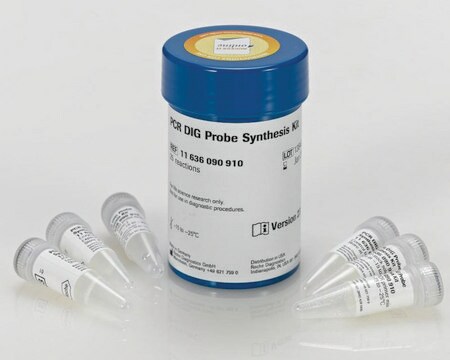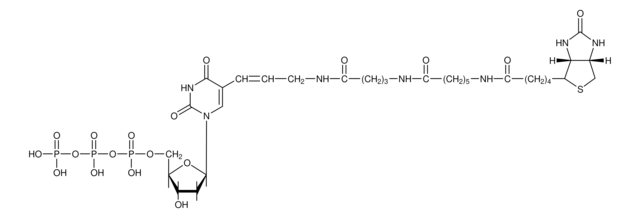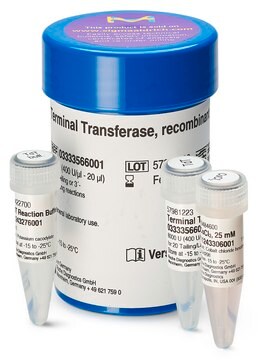DIUTPS-RO
Roche
Digoxigenin-11-dUTP, alkali-stable
Sinonimo/i:
Digoxigenin-11-dUTP, alkali-labile
Autenticatiper visualizzare i prezzi riservati alla tua organizzazione & contrattuali
About This Item
Codice UNSPSC:
41105500
Prodotti consigliati
Saggio
≥85% (HPLC)
Livello qualitativo
Stato
solution
PM
Mr 1090.7
Confezionamento
pkg of 125 μL (11558706910 [1 mM])
pkg of 5 × 125 μL (11570013910 [5x1 mM])
pkg of 25 μL (11093088910 [1 mM])
Produttore/marchio commerciale
Roche
λmax
222 and 292 nm
22430 and 8780
Temperatura di conservazione
−20°C
Cerchi prodotti simili? Visita Guida al confronto tra prodotti
Descrizione generale
Digoxigenin-11-dUTP, alkali-stable is provided in 1 mM tetralithium salt, solution.
Applicazioni
Digoxigenin-11-dUTP, alkali-stable has been used to label probes for
fluorescent in situ hHybridization (FISH) and polymerase chain reaction (PCR)
Note: When this nucleotide is subjected to 0.1 - 0.5 NaOH at +15 to +25°C, the DIG moiety will remain attached. It is therefore ideal for use in DIG-labeled DNA that needs to survive exposure to alkaline treatment. However, if you intend to make a DIG-labeled probe that can be removed by alkali denaturation (e.g ., during stripping and reprobing of blots), do not use this alkali-stable preparation. Instead, use the alkali-labile form of DIG-11-dUTP.
fluorescent in situ hHybridization (FISH) and polymerase chain reaction (PCR)
Note: When this nucleotide is subjected to 0.1 - 0.5 NaOH at +15 to +25°C, the DIG moiety will remain attached. It is therefore ideal for use in DIG-labeled DNA that needs to survive exposure to alkaline treatment. However, if you intend to make a DIG-labeled probe that can be removed by alkali denaturation (e.g ., during stripping and reprobing of blots), do not use this alkali-stable preparation. Instead, use the alkali-labile form of DIG-11-dUTP.
Azioni biochim/fisiol
Digoxigenin (DIG)-11-deoxyuridine triphosphate (dUTP) replaces deoxythymidine triphosphate (dTTP) in the random-primed DNA labeling reaction or in nick translation in a ratio of 35% DIG-11-dUTP and 65% dTTP. DIG-11-dUTP can also replace dTTP in labeling during polymerase chain reaction (PCR) (e.g., with Taq DNA Polymerase), 3′-tailing (with terminal transferase) and cDNA synthesis (e.g., with transcriptor or M-MuLV reverse transcriptase). It is ideal as a substrate for DNA polymerase, Taq DNA polymerase, terminal transferase and reverse transcriptase.
Caratteristiche e vantaggi
Digoxigenin is bound to deoxyuridine triphosphate via an alkali-resistant ether linkage.
Resistance to alkali: The preparation is stable in the presence of 0.1 - 0.5M NaOH at +15 to +25°C.
Resistance to alkali: The preparation is stable in the presence of 0.1 - 0.5M NaOH at +15 to +25°C.
Qualità
Typical analysis: At least 85% DIG-11-dUTP (HPLC, area%).
Function tested by RPL.
Function tested by RPL.
Nota sulla preparazione
Working solution: We recommend to prepare a deoxynucleotide mix containing dATP, dCTP, dGTP, dTTP (10 mM, each); (e.g., for the preparation of 100 μl nucleotide mix add 10 μl of dATP, dCTP, dGTP, dTTP (each) to 60 μl Water, PCR Grade).
Storage conditions (working solution): A decomposition of approx. 5% may occur within 4 weeks at 15 to 25 °C.
Storage conditions (working solution): A decomposition of approx. 5% may occur within 4 weeks at 15 to 25 °C.
Altre note
For life science research only. Not for use in diagnostic procedures.
Codice della classe di stoccaggio
12 - Non Combustible Liquids
Classe di pericolosità dell'acqua (WGK)
nwg
Punto d’infiammabilità (°F)
does not flash
Punto d’infiammabilità (°C)
does not flash
Scegli una delle versioni più recenti:
Possiedi già questo prodotto?
I documenti relativi ai prodotti acquistati recentemente sono disponibili nell’Archivio dei documenti.
I clienti hanno visto anche
The Arabidopsis thaliana DSB formation (AtDFO) gene is required for meiotic double-strand break formation
Zhang C, et al.
The Plant Journal, 72 (2012)
Frequency of aneuploidy in in vitro--matured MII oocytes and corresponding first polar bodies in two dairy cattle (Bos taurus) breeds as determined by dual-color fluorescent in situ hybridization
Nicodemo D, et al.
Theriogenology, 73 (2010)
TRF2 and lamin A/C interact to facilitate the functional organization of chromosome ends
Wood AM, et al.
Nature Communications, 5, 5467-5467 (2014)
Antony W Shermoen et al.
Current biology : CB, 20(23), 2067-2077 (2010-11-16)
Fast, early embryonic cell cycles have correspondingly fast S phases. In early Drosophila embryos, forks starting from closely spaced origins replicate the whole genome in 3.4 min, ten times faster than in embryonic cycle 14 and a hundred times faster
Yingxiang Wang et al.
PLoS genetics, 8(11), e1003039-e1003039 (2012-11-13)
During meiotic recombination, induced double-strand breaks (DSBs) are processed into crossovers (COs) and non-COs (NCO); the former are required for proper chromosome segregation and fertility. DNA synthesis is essential in current models of meiotic recombination pathways and includes only leading
Il team dei nostri ricercatori vanta grande esperienza in tutte le aree della ricerca quali Life Science, scienza dei materiali, sintesi chimica, cromatografia, discipline analitiche, ecc..
Contatta l'Assistenza Tecnica.





